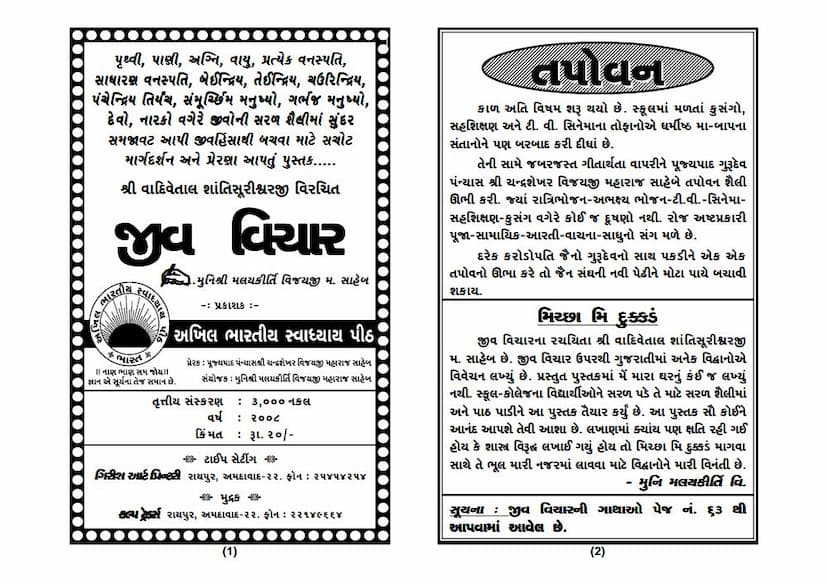Jiva Vichara
Added to library: September 2, 2025

Summary
This summary is based on the provided text, which appears to be excerpts from the Jain text "Jiva Vichara" by Muni Malaykirtivijayji.
Book Title: Jiva Vichara (A Treatise on Souls)
Author: Muni Malaykirtivijayji (with original composition attributed to Shri Vadivetala Shantisurishwarji)
Publisher: Malaykirtivijayji
Core Purpose: The book aims to provide a clear and simple explanation of the nature and classification of souls (Jivas) according to Jain philosophy. It seeks to guide readers, especially students, to understand these concepts and to cultivate compassion and a commitment to non-violence (Ahimsa) by refraining from harming living beings.
Key Themes and Concepts:
-
Classification of Souls (Jivas): The text meticulously details the classification of souls based on the number of senses they possess, their mode of existence, and their location in the universe.
- Ekindriya (One-sensed souls): These are the stationary (Sthavar) souls, further divided into:
- Prithvi Kay (Earth-bodied souls): Souls residing in earth substances like gems, metals, soil, and stones.
- Apas Kay (Water-bodied souls): Souls residing in water substances like rivers, oceans, rain, and ice.
- Teu Kay (Fire-bodied souls): Souls residing in fire substances like embers and lightning.
- Vayu Kay (Air-bodied souls): Souls residing in air.
- Vanaspati Kay (Plant-bodied souls): Souls residing in plants. This category is further divided into:
- Pratyek Vanaspati: Plants with a single soul per body (e.g., trees, fruits).
- Sadharan Vanaspati: Plants with infinite souls residing in a single body (e.g., potatoes, onions, fungi), also called Nigod. These are highlighted as having immense suffering.
- Viklendriya (Incomplete-sensed souls): These are mobile (Tras) souls that lack all five senses.
- Beindriya (Two-sensed souls): Possessing touch and taste senses (e.g., worms, snails).
- Teindriya (Three-sensed souls): Possessing touch, taste, and smell senses (e.g., ants, lice).
- Chaurindriya (Four-sensed souls): Possessing touch, taste, smell, and sight senses (e.g., scorpions, flies, mosquitoes).
- Panchendriya (Five-sensed souls): Possessing all five senses.
- Tiryañch Panchendriya (Animals/Beasts): Further classified into:
- Jalchar (Aquatic)
- Sthalchar (Terrestrial) - Subdivided into Chaturpad (four-legged), Urparisarpa (crawling on belly), and Bhujparisarpa (crawling on hands/limbs).
- Khechar (Aerial) - Subdivided into those with feathered wings and those with leathery wings.
- These are also classified as Gambhaj (born from a womb) and Sammurchhim (spontaneously generated).
- Manushya (Humans): Found in the middle realm (Madhylok), specifically within the Adhai Dweep (Two and a Half Continents). Humans are categorized into 101 "fields" of habitation, leading to 303 types based on generation (Gambhaj/Sammurchhim) and completeness of vital faculties (Paryapta/Aparyapta).
- Devas (Celestial Beings): Residing in the upper realms (Urdhvalok). They are classified into Bhavanpati (dwelling beings), Vyantar (intermediate beings), Jyotishk (luminous beings), and Vaimanik (celestial palace dwellers).
- Naraka (Hell Beings): Residing in the lower realms (Adholok) and experiencing immense suffering. They are classified into 7 main hell-realms.
- Tiryañch Panchendriya (Animals/Beasts): Further classified into:
- Ekindriya (One-sensed souls): These are the stationary (Sthavar) souls, further divided into:
-
Jiva vs. Ajiva: The fundamental distinction is made between Jiva (soul), which is conscious and capable of experiencing happiness and sorrow, and Ajiva (non-soul), which is inert and unconscious.
-
Bhavana and Moksha: The text implies that understanding these classifications is crucial for spiritual progress. The ultimate goal for a soul is to break free from the cycle of birth and death (Samsara) and attain liberation (Moksha), becoming a Siddha.
-
Ahimsa (Non-Violence): The emphasis is on understanding the presence of souls in various forms of life to foster compassion and prevent harm. The book highlights the immense violence involved in consuming certain foods (like root vegetables, fungi) due to the presence of numerous souls.
-
Paryapta and Aparyapta: Souls are classified based on whether they have fully developed their vital faculties (Paryapta) or not (Aparyapta). These faculties include food intake, body formation, sense organs, breathing, speech, and mind.
-
Ayushya (Lifespan): The text details the lifespans of various beings, ranging from extremely short (Antarmuhurta for some souls) to incredibly long (Sagaropama for celestial and hell beings).
-
Sva-kayasthiti (Self-body Condition): This refers to the maximum number of consecutive lives a soul can spend in a particular bodily form.
-
Prana (Vital Forces): The text describes ten vital forces that sustain life: the five senses, mental strength, speech strength, bodily strength, respiration, and lifespan.
-
Yoni (Origin/Birthplace): The classification of births into 8.4 million categories based on the nature of the origin.
-
Cosmology: The text provides details about the structure of the universe, including the Middle Realm (Madhylok) with its numerous continents (Dweeps) and oceans, and the Upper (Urdhvalok) and Lower (Adholok) realms.
-
Style: The book is written in a simple, accessible style, making complex Jain philosophical concepts understandable for a wider audience, including students. It uses analogies and explanations to clarify the teachings.
Overall Message: "Jiva Vichara" is a foundational text for understanding Jain metaphysics, emphasizing the omnipresence of souls in diverse forms of existence. It serves as a practical guide to cultivate compassion and a deep respect for all life, thereby promoting a path towards spiritual liberation. The book's effort to simplify complex ideas aims to empower readers to live a life guided by the principles of Jainism.